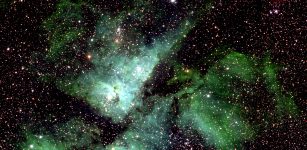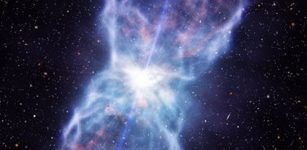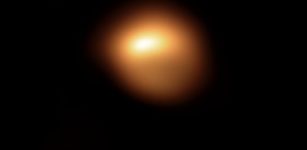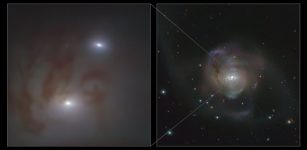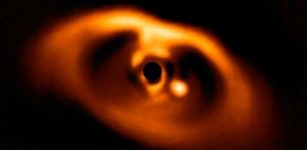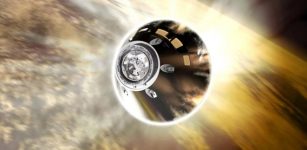Astronomers Discover Moon-Forming Disk Around Distant Planet
Eddie Gonzales Jr. – MessageToEagle.com – Using Earth’s most powerful array of radio telescopes, astronomers have observed a circumplanetary disk of gas and dust like the one that is believed to have birthed the moons of Jupiter.
The find adds to the intriguing story of planet PDS 70 c, a still-forming gas giant about 370 light years from Earth that was first revealed last month in visible light images.
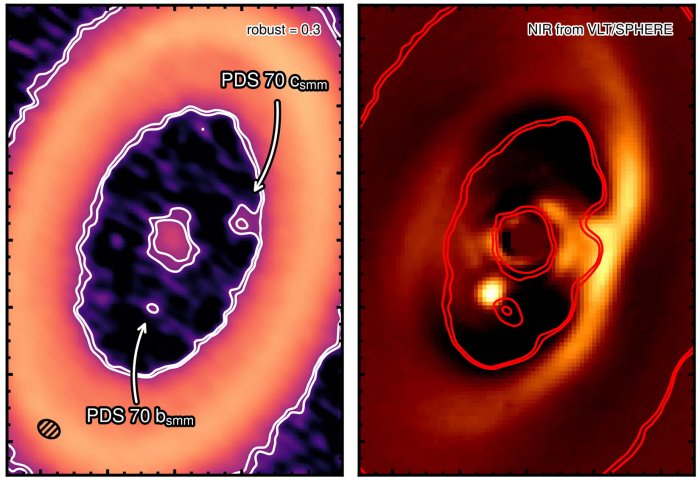 Radio astronomers using the Atacama Large Millimeter/submillimeter Array of telescopes in Chile have found a disk of gas and dust (left) around exoplanet PDS 70 c, a still-forming gas giant that was obscured from view in the 2018 infrared image (right) that first revealed its sister planet, PDS 70 b. (Image courtesy of A. Isella, ALMA (ESO/NAOJ/NRAO))
Radio astronomers using the Atacama Large Millimeter/submillimeter Array of telescopes in Chile have found a disk of gas and dust (left) around exoplanet PDS 70 c, a still-forming gas giant that was obscured from view in the 2018 infrared image (right) that first revealed its sister planet, PDS 70 b. (Image courtesy of A. Isella, ALMA (ESO/NAOJ/NRAO))
Using the massive 66-antenna Atacama Large Millimeter/submillimeter Array (ALMA) in Chile, Rice University astronomer Andrea Isella and colleagues collected millimeter wave radio signals that revealed the presence of dust grains throughout the star system where PDS 70 c and its sister planet, PDS 70 b, are still forming.
“Planets form from disks of gas and dust around newly forming stars, and if a planet is large enough, it can form its own disk as it gathers material in its orbit around the star,” Rice University astronomer Andrea Isella, said in a press release.
“Jupiter and its moons are a little planetary system within our solar system, for example, and it’s believed Jupiter’s moons formed from a circumplanetary disk when Jupiter was very young.”
But most models of planet formation show that circumplanetary disks disappear within about 10 million years, which means circumplanetary disks haven’t existed in our solar system for more than 4 billion years. To look for them elsewhere and gather observational evidence to test theories of planet formation, the team searched for very young star systems where they can directly observe disks and the planets still forming inside them.
“There are a handful of candidate planets that have been detected in disks, but this is a very new field, and they are all still debated,” Isella said. “(PDS 70 b and PDS 70 c) are among the most robust because there have been independent observations with different instruments and techniques.”
 A color-enhanced image of millimeter-wave radio signals from the ALMA observatory in Chile shows a disk of gas and dust (right of center) around exoplanet PDS 70 c, the first-ever observation of the kind of circumplanetary disk that is believed to have birthed the moons of Jupiter more than 4 billion years ago. (Image courtesy of A. Isella, ALMA (ESO/NAOJ/NRAO)
A color-enhanced image of millimeter-wave radio signals from the ALMA observatory in Chile shows a disk of gas and dust (right of center) around exoplanet PDS 70 c, the first-ever observation of the kind of circumplanetary disk that is believed to have birthed the moons of Jupiter more than 4 billion years ago. (Image courtesy of A. Isella, ALMA (ESO/NAOJ/NRAO)
PDS 70 is a dwarf star about three-quarters the mass of the sun. Both of its planets are 5-10 times larger than Jupiter, and the innermost, PDS 70 b, orbits about 1.8 billion miles from the star, roughly the distance from the sun to Uranus. PDS 70 c is a billion miles further out, in an orbit about the size of Neptune’s.
PDS 70 b was first revealed in 2018 in infrared light images from a planet-hunting instrument called SPHERE at the European Southern Observatory’s Very Large Telescope (VLT). In June, astronomers used another VLT instrument called MUSE to observe a visible wavelength of light known as H-alpha, which is emitted when hydrogen falls onto a star or planet and becomes ionized.
“H-alpha gives us more confidence that these are planets because it suggests they are still drawing in gas and dust and growing,” Isella said.
The millimeter wavelength observations from ALMA provide even more evidence.
Written by Eddie Gonzales Jr. – MessageToEagle.com Staff

